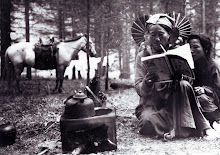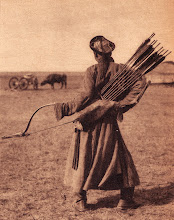RUBIN MUSEUM OF ART and Media That Matters present
Lunch Matters: THE NOMADIC PEOPLES PROJECT
Wednesdays at 1 p.m.
$10 / Free to RMA members
(Tickets include a post-program tour of the galleries)
The Nomadic Peoples Project brings attention to the rich cultural history and challenging modern-day realities for nomadic communities in today's era of global industrialization, denuded natural resources and the marginalization of nomadic traditions.
January 7th, 2009 JUNGLE NOMADS OF THE HIMALAYAS
For centuries the Raji nomads of the Himalayan foothills have collected wild bee honey. Climbing the incredibly tall trees of the Terai jungle, they risk their lives to harvest this honey, made by the world's largest migrating bees.
January 14th, 2009 -
RIDING THE RAILS
At the height of the Great Depression more than a quarter of a million teenagers lived on the road in America, many crossing the country by illegally hopping freight trains. This award-winning documentary follows the stories of ten teenage hobos while echoing the lives of today's migrant laborers, who continue this tradition of a nomadic lifestyle.
Post-screening Q&A with filmmakers Michael Uys & Lexy Lovell
January 21st, 2009  Mongolia: Land Without Fences
Mongolia: Land Without FencesMore than half of Mongolia's two and a half million people live as nomads. Withstanding an already harsh landscape, the lives of these nomadic peoples have become even more difficult thanks to catastrophic winters, which have killed off large numbers of livestock in the country.
Post-screening Q&A with Casey Beck
Afghan Nomads: The MaldarFrom the foothills of the Hindu Kush the nomadic Maldar people reflect a centuries-old mixture of faith and distrust that has kept them - and nomads around the world - both separated from and dependent on settled peoples.

‘
Uncontacted Tribes’ by Survival International. This documentary conveys the urgency of the threats to nomadic hunter gathering peoples in two hemispheres. We witness the struggles of the Sentinelese known as one of the most isolated of the world’s tribes, the Andaman Islanders, the last of the Akuntsu people of Brazil and Indian tribes of Eastern Peru.
January 28th, 2009
-
A NOMAD'S LIFE from the eighth annual MTM Festival
Post-screening Q&A with filmmakers Lynne True & Nelson Walker
In Tibet's Kham region a young family questions whether their nomadic traditions can survive against the challenges of a rapidly modernizing world.

“
Pahdopony: See How Deep the Water Is” by Hotke Productions. Comanche woman artist Pahdopony introduces us to the life of her Comanche ancestors through her art and words. The Comanche Nation’s legendary history as one of the great nomadic peoples of North America is brought to life as Pahdopony’s art speaks to the great past and present of her people’s lives.
Directed by Annette Arkeketa

‘
Uncontacted Tribes’ by Survival International. This documentary conveys the urgency of the threats to nomadic hunter gathering peoples in two hemispheres. We witness the struggles of the Sentinelese known as one of the most isolated of the world’s tribes, the Andaman Islanders, the last of the Akuntsu people of Brazil and Indian tribes of Eastern Peru.
Produced by Survival International.

“
Nomads” by photographer Cat Vinton takes us on an enchanting journey into the world of nomadic people in Mongolia and Inner Finmark in Norway. Cat Vinton’s breathtakingly beautiful photographs fling the viewers into the distant reaches of Mongolia’s Gobi Desert and Norway’s big sky country, where fantasy shares an interlude with the timeless beauty of a stark nomadic existence in sub-artic cold.
Created by Cat Vinton, Edited by Ed Katzler
EAT WHILE YOU WATCH:
Visitors are encouraged to bring their lunch and drinks from the Cafe @ RMA down to the theater to enjoy during Lunch Matters. The Cafe @ RMA offers a wide range of seasonal food and beverage items inspired by the regions and flavors of the Himalayas. Sample new menu items include spicy potato and cheese samosas, tandoori masala vegetable sandwiches in fresh onion naan, as well as beverages such as chai, homemade lassis, and select specialty regional teas.
PROGRAM TICKET INCLUDES ADMISSION TO:
The Last Nomads: The Wuzhu Muqin are the last remaining nomadic tribe in China, and have become Mongolian photographer A Yin's source of inspiration. Yin has become his people's advocate, exposing to the rest of the world the ancient lifestyle they maintain in the face of rapid modernization. Comprised of images captured over ten years, The Last Nomads: Photographs from Inner Mongolia by A Yin offers a striking visual account of daily life in the Inner Mongolian highlands: from the labors of migration to the intimacies of kinship. A Yin is a 2007 recipient of the All Roads Film and Photography Program award, sponsored by the National Geographic Society.
RUBIN MUSEUM OF ART
150 WEST 17TH STREET, NEW YORK CITY 212.620.5000 x344 www.rmanyc.org



















